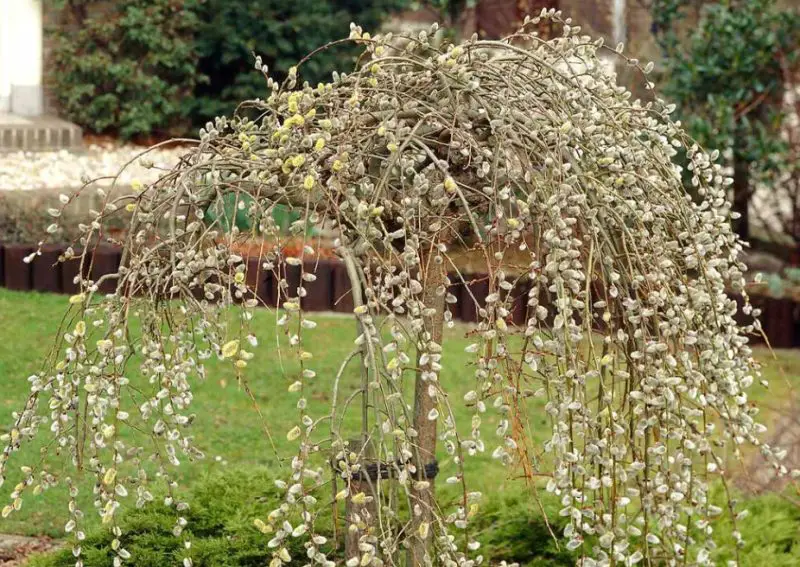The Weeping Pussy Willow, known for its graceful, cascading branches and soft catkins, is a stunning ornamental tree that brings beauty to gardens in early spring. Its unique weeping shape makes it a focal point in landscapes, and its early blooming flowers are among the first signs of the changing season. This plant is admired not only for its striking appearance but also for its ability to attract pollinators like bees.
Native to cooler regions, this willow thrives in moist soils and enjoys abundant sunlight. Gardeners love it for its adaptability, making it suitable for both small home gardens and larger landscapes. Proper care, however, is essential to maintain its attractive form and ensure healthy growth throughout the year.
If you’re planning to grow a Weeping Pussy Willow in your garden, understanding its growing conditions, watering needs, pruning requirements, and common issues will help you keep it flourishing for years. This guide provides everything you need to know to cultivate a thriving and vibrant willow.
Table of Contents
Understanding the Weeping Pussy Willow

Characteristics and Appearance
The Weeping Pussy Willow is a deciduous tree with long, arching branches that hang gracefully toward the ground. Its catkins, which appear in late winter or early spring, are soft, silvery-gray, and gradually turn yellow as they mature. These fuzzy catkins are the hallmark of the tree and often used in floral arrangements for their decorative appeal.
This tree typically grows between 6 to 10 feet tall, making it a suitable choice for gardens with limited space. Its branches form a rounded, cascading shape, giving it a natural elegance. The leaves are narrow, green, and slightly glossy, adding to its ornamental charm during the growing season.
In addition to its beauty, the Weeping Pussy Willow is known for being relatively fast-growing. With proper care, it can quickly establish itself and become a centerpiece in any garden.
Ideal Climate and USDA Hardiness Zones
Weeping Pussy Willows grow best in USDA hardiness zones 4 to 8, where winters are cold enough to encourage healthy dormancy and springs are cool and moist. They prefer temperate climates and may struggle in areas with extremely hot and dry summers.
The tree performs exceptionally well in regions with abundant rainfall or consistent watering. If you live in a dry or arid area, you will need to provide extra irrigation to keep the soil moist, as the tree does not tolerate prolonged drought.
Growing Conditions for Weeping Pussy Willow
Soil Requirements
The Weeping Pussy Willow thrives in moist, well-drained soil rich in organic matter. Loamy soil with good water retention is ideal, but the tree can adapt to clay or sandy soils if proper amendments are made. Adding compost or well-rotted manure before planting enhances soil fertility and improves moisture retention.
The soil pH should ideally be slightly acidic to neutral, ranging from 6.0 to 7.0. Although the willow is adaptable, alkaline soils can limit nutrient availability and affect its growth over time.
Sunlight and Placement
This tree loves full sun and requires at least six hours of direct sunlight daily to produce abundant catkins and maintain healthy growth. Partial shade is tolerated, but too much shade can cause sparse blooming and weak branch development.
When choosing a planting location, select an open area where the cascading branches can spread naturally without obstruction. Avoid planting too close to buildings or walkways, as the branches can extend several feet outward.
Watering Needs
Weeping Pussy Willows require consistent moisture, especially during their first few years of growth. Newly planted trees should be watered deeply at least once a week, ensuring the soil remains evenly moist. Mature trees are more drought-tolerant but still benefit from regular watering during dry periods.
Overwatering should be avoided, as constantly soggy soil can lead to root rot. A good rule is to keep the soil consistently moist but not waterlogged.
Planting Weeping Pussy Willow
When to Plant
The best time to plant a Weeping Pussy Willow is in early spring or late fall when the tree is dormant. Planting during these periods allows the roots to establish before the active growing season or before the coldest part of winter arrives.
Avoid planting during extremely hot summer months, as heat stress can make it difficult for the tree to adjust to its new environment.
How to Plant for Best Growth
Begin by digging a hole twice as wide and just as deep as the root ball. Loosen the surrounding soil to encourage root expansion, and mix compost into the soil if it is poor in nutrients. Place the tree in the hole so that the root collar is level with the ground surface.
Backfill the hole with the amended soil, pressing gently to eliminate air pockets. Water thoroughly after planting to help the soil settle and keep the roots hydrated. Applying a two- to three-inch layer of mulch around the base helps conserve soil moisture and suppress weeds.
Weeping Pussy Willow Care Throughout the Year
Fertilizing for Healthy Growth
Fertilization helps support lush foliage and abundant catkin production. A balanced, slow-release fertilizer applied in early spring as new growth begins will encourage healthy development. Avoid excessive nitrogen, as it may encourage too much leafy growth at the expense of catkins.
In nutrient-rich soil, fertilization may not be necessary every year. However, if your tree shows signs of poor growth, yellowing leaves, or reduced blooming, an annual feeding can be beneficial.
Pruning and Shaping
Pruning is essential to maintain the elegant weeping shape and prevent overcrowding of branches. The best time to prune is late winter or early spring before new growth emerges. Remove any dead, damaged, or crossing branches, and trim back long shoots to encourage fuller growth.
For a well-shaped canopy, focus on maintaining the natural cascading form rather than heavily cutting back the branches. Over-pruning can ruin the tree’s graceful appearance and stress the plant.
Mulching and Soil Maintenance
Mulching plays an important role in conserving soil moisture and protecting roots. Organic mulch such as shredded bark or compost also enriches the soil as it breaks down. Maintain a mulch layer two to three inches thick, but keep it a few inches away from the trunk to prevent rot.
Regularly check soil moisture and condition, especially in hot weather. Loosen compacted soil around the base occasionally to improve air circulation to the roots.
Common Problems and Solutions
Pests and Diseases
Weeping Pussy Willows are relatively hardy but can occasionally suffer from pests such as aphids, scale insects, and spider mites. These insects feed on sap, causing leaf curling or yellowing. A strong blast of water or insecticidal soap can help control light infestations.
Fungal diseases such as willow blight or powdery mildew may appear in humid conditions. Proper spacing, good air circulation, and avoiding overhead watering reduce the risk of fungal infections. If infections occur, pruning affected branches and applying fungicides can help manage the problem.
Environmental Stress
Drought stress, excessive heat, or waterlogged soil can weaken the tree and reduce flowering. Ensuring proper watering practices and choosing an appropriate planting location helps prevent these issues. In extremely windy areas, young trees may need staking to prevent leaning or damage to the delicate branches.
Propagation of Weeping Pussy Willow
Weeping Pussy Willows are easy to propagate through cuttings. In late winter or early spring, take a healthy stem cutting about 8 to 10 inches long and place it in moist soil or water. The cuttings usually develop roots within a few weeks, making them an accessible option for gardeners who wish to expand their collection.
Growing new trees from cuttings is also cost-effective and ensures that the new plants will have the same weeping form as the parent plant.
Using Weeping Pussy Willow in Landscaping
The graceful shape and early spring catkins make this tree an excellent choice for ornamental landscaping. It works well as a focal point in garden beds, near water features, or along pathways. The weeping branches provide movement and texture, creating a calming and elegant garden atmosphere.
When planted in groups, they can form a stunning visual display, especially when the catkins are in full bloom. Pairing them with spring-flowering bulbs or early-blooming shrubs enhances seasonal interest.
FAQs About Weeping Pussy Willow Care
How fast does a Weeping Pussy Willow grow?
Weeping Pussy Willows are considered fast-growing trees, typically adding 2 to 4 feet of growth per year under ideal conditions. With proper watering and fertilization, they establish quickly and develop their signature weeping shape within the first few years.
When should I prune my Weeping Pussy Willow?
The best time to prune a Weeping Pussy Willow is in late winter or early spring, before new growth begins. Pruning during this period promotes healthy branching, improves air circulation, and maintains the graceful weeping form.
How often should I water a Weeping Pussy Willow?
Young Weeping Pussy Willows should be watered deeply once or twice a week, keeping the soil consistently moist. Mature trees can tolerate short dry periods but benefit from regular watering during hot or dry weather to maintain healthy growth.
Can I grow a Weeping Pussy Willow in a container?
Yes, Weeping Pussy Willows can be grown in large containers, especially dwarf or grafted varieties. Ensure the container has good drainage, use rich potting soil, and water regularly to keep the roots moist.
What causes yellowing leaves on a Weeping Pussy Willow?
Yellowing leaves may result from overwatering, poor drainage, or nutrient deficiencies. Check soil moisture levels and consider applying a balanced fertilizer in early spring to restore healthy leaf color.
Conclusion
The Weeping Pussy Willow is a charming and low-maintenance ornamental tree that rewards gardeners with its beautiful cascading branches and delightful catkins. With proper planting, regular watering, annual pruning, and attention to soil health, this tree can thrive for many years, becoming a highlight in your garden.
By understanding its growing requirements and providing consistent care, you can enjoy a healthy, vigorous Weeping Pussy Willow that brightens your landscape each spring. Whether used as a single focal point or as part of a larger planting scheme, this tree adds timeless elegance and seasonal beauty to any outdoor space.






